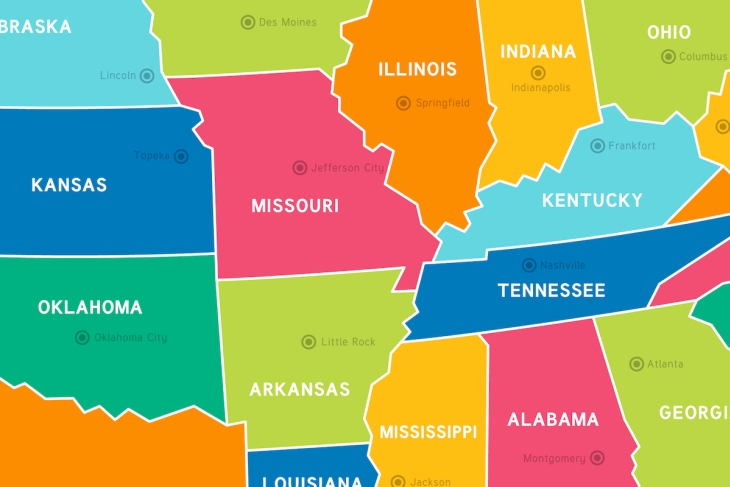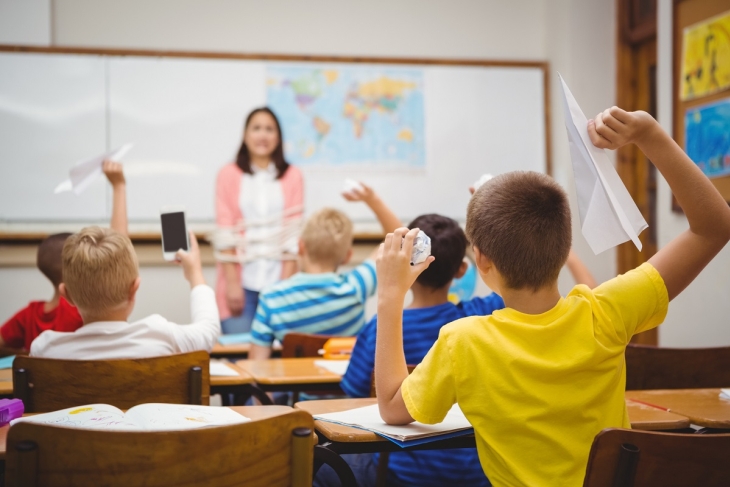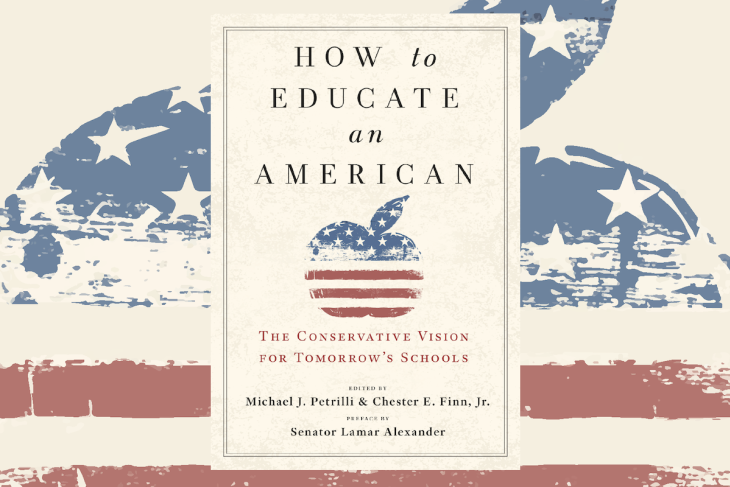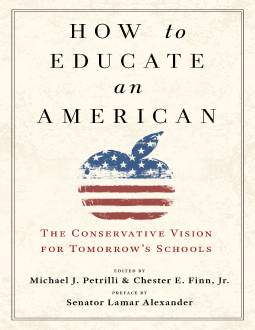Editor’s note: What follows is a reprinting of the preface to an important new book, How to Educate an American: The Conservative Vision for Tomorrow’s Schools, edited by Fordham’s Michael J. Petrilli and Chester E. Finn, Jr., and published by Templeton Press.
I was participating in a humdrum educators’ roundtable in Buffalo, New York, in 1988 when “Monk” Malloy, president of the University of Notre Dame, asked this question: “What is the purpose of a public school?”
There was a long silence until finally Albert Shanker, president of the American Federation of Teachers, proposed this answer: “The public school was created for the purpose of teaching immigrant children reading, writing, and arithmetic and what it means to be an American with the hope that they would then go home and teach their parents.” The reason to read this book is to judge for yourself whether the twenty-two conservative luminaries who wrote its chapters have produced a better answer today to Malloy’s question than Albert Shanker did thirty years ago.
Shanker was a patriot—an old-fashioned, anticommunist, Hubert Humphrey–liberal Democrat union organizer whose parents had immigrated from Poland. So he and this book’s conservative writers agreed on one thing: In coeditor Chester Finn’s words, “Schools should inculcate a solid understanding of and appreciation for why America exists and what it stands for, to transmit history and civics and, yes, a positive attitude toward its strengths as well as a reasoned commitment to addressing its weakness.” Or, in Shanker’s words, “Public schools played a big role in holding our nation together. They brought together children of different races, languages, religions, and cultures and gave them a common language and a sense of common purpose. We have not outgrown our need for this; far from it.”
Today, there is elite disdain for such Americanism. But this is not a popular attitude. Most audiences applaud and some come to their feet when I say, “We should teach more United States history in our schools so our children can grow up knowing what it means to be an American.” There is bipartisan support for this sentiment. After September 11, 2001, George W. Bush and Al Gore both reminded the nation that principles create the American character—not considerations of race, religion, or national origin. In my first address to the US Senate, I introduced a bill to create summer academies for outstanding students and teachers of US history. Within a day, Senator Ted Kennedy had rounded up nearly twenty Democratic cosponsors without my asking. Especially in today’s internet democracy, an era Peggy Noonan calls “The Great Estrangement,” Americans are hungry for institutions that unite. I suspect that most would agree that it would be a good idea to begin each school day with a student leading the Pledge of Allegiance and then giving his or her version of what it means to be an American.
According to education historian Patricia Graham, “Schools in America have danced to different drummers through their long history”—and schools have a very long history. Hunter-gatherer “play schools” helped children learn to survive. Sumerian schools taught scribes to help a culture survive. During the Agricultural and Industrial Revolutions, schools taught youngsters to work and got them out from under their parents’ feet. Sociologist James Coleman said that in early America, schools helped parents do what parents could not do as well. That was especially true for teaching literacy. Graham says, “Now the drumbeat demands that all children achieve academically at a high level and the measure of that achievement is tests.”
This book’s conservative writers would temper that drumbeat with a second great conservative goal—in the coeditors’ words, “to restore character, virtue, and morality to the head of the education table where they belong.” This is no new thought. Plato said schools should create good men who act nobly. Thomas Jefferson believed that a democracy granting broad liberties needed institutions instilling moral restraint. But Yuval Levin’s essay suggests why character education does not rise so easily on a liberal list of priorities: progressive education wants to liberate the student to be himself or herself, Levin writes, while conservative education wants to form the student to be better suited to the responsibilities of citizenship.
After embracing citizenship and character, the book’s authors diverge in their emphases. Several show a healthy respect for school choice but also for its limits. There is a shout-out for career and technical education. To me, Bill Bennett’s chapter is the most persuasive. He argues that content must be at the center of any conservative consensus on education. He reminds us that in the 1980s and 1990s, conservatives were leading a content crusade with E. D. Hirsch and Governors John Engler, Tommy Thompson, and Jeb Bush as well as Bennett himself as chief architects. This movement was called (shall we whisper it?) “Common Core.” This state-by-state reformation of school standards and curricula was well underway when the Obama administration tried to push it faster by making Common Core a quasi-federal mandate. Republicans imagined black helicopters flying. What conservatives had invented, many Republican legislators had voted into state law, and hundreds of thousands of classroom teachers in forty-five states expected they’d be teaching was suddenly condemned and abandoned...by conservatives.
This abandonment was less complete than it would appear. Last year, our daughter’s family lived with us in Tennessee while her home was being remodeled. She placed two sons in a nearby mountain elementary school. When the boys returned home to their Westchester County, New York, public school, I asked, “Did they have trouble adjusting?” “Nope,” she said. “Common Core here. Common Core there.” Many states simply renamed Common Core to avoid political flak and charged ahead. One advocate told me, “We won. But we’re not allowed to say so.”
The backlash to Common Core brings me to the most obvious mission missing from this volume’s conservative agenda: local control of schools. America was created community by community. The initiative for American public schools was entirely at the local level, Marc Tucker has written. He termed this an “accident of localism.”
I have spent much of my public life trying to preserve this localism. To begin with, federalism—the dispersal of central authority—is a crucial tenet of American liberty. Our revolution, after all, was mostly about distaste for a king. As a practical matter, my experience is that those governing education from a distance have good intentions but limited capacity and that schools can be only as good as parents, teachers, and citizens in a community want them to be. The saga of Common Core is the greatest proof of this pudding. Here was a conservative crusade—new rigor in what students needed to know—blown up by conservatives’ fear that Washington, D.C., was forcing them to do it. The Common Core federal directive was piled on top of other dictates from Presidents Bill Clinton, George W. Bush, and Barack Obama on how to define standards, teaching, tests, curricula, and remedies for low-performing schools. Almost everyone in public schools became sick of Washington telling them what to do. So, in 2015, teacher unions and governors united to help Congress enact the “Every Student Succeeds Act,” which the Wall Street Journal said was “the largest devolution of federal control to the states in a quarter century.”
Now, after the rise and fall of a national school board, our one hundred thousand public schools have about the same balance between federal leadership and state and local autonomy that existed during the George H. W. Bush administration. Once again, we have it about right. Thirty years ago, President Bush and the governors set the nation’s first national education goals and then launched an “America 2000” initiative to help states meet those goals by creating voluntary standards, voluntary tests, and start-from-scratch schools. This was done the hard way, state by state and community by community—not by federal mandates. Today’s environment is ripe for a revival of a content-based conservative consensus, or in Bill Bennett’s words “a great relearning,” as the best way for our public schools to help our country get where we want it to go. But this time, let’s avoid the lure of federal mandates and do the job the American Way: state by state, community by community.








